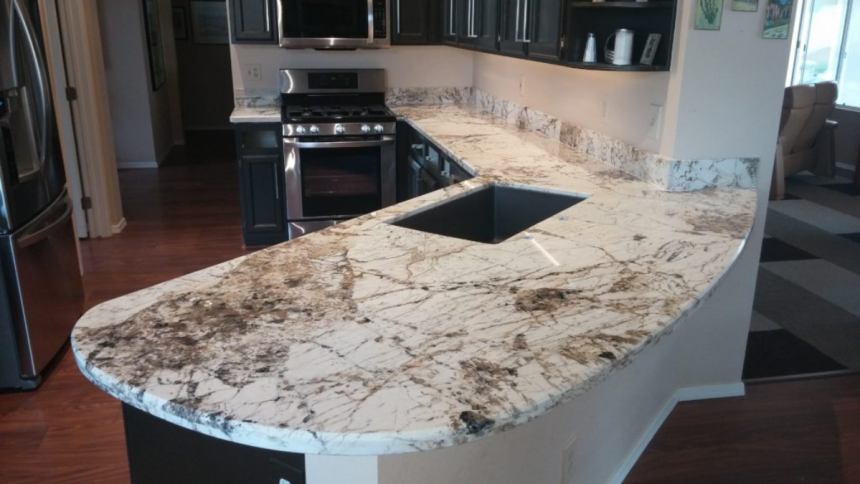Granite is one of the most enduring symbols of luxury in home design. Known for its rich colors, complex patterns, and rugged durability, it’s a popular choice in homes across the globe. But before granite countertops reach the kitchens they transform, they travel a path millions of years in the making.
From its origins deep within the earth’s crust to its final polished form, the story of granite is both ancient and surprisingly modern. Understanding that journey helps homeowners appreciate more than just the aesthetic—it connects them to the natural and technological processes that shape their living spaces.
Here’s a look behind the scenes, following granite from quarry to kitchen.
Born of Fire and Time
Granite begins as molten rock, formed by intense heat and pressure miles beneath the Earth’s surface. Over millions of years, that magma cools slowly, allowing large crystals of quartz, feldspar, and mica to form.
This geological process gives granite its defining characteristics: hardness, density, and distinct patterning. Unlike manufactured surfaces, no two granite slabs are alike. Each one is a unique geological fingerprint, created over eons and shaped by natural forces beyond human control.
It’s this individuality—fused with extreme durability—that makes granite so desirable in modern homes.
The Art and Science of Extraction
The next step in the granite journey happens in quarries located around the world. Brazil, India, and Italy are some of the most prominent sources, though many domestic quarries operate in the United States as well.
Granite is extracted from these massive pits in blocks weighing several tons. High-powered diamond wire saws are used to make clean cuts while minimizing waste. Explosives are rarely used today, as they can damage the stone and create uneven surfaces.
Quarrying is a delicate balance between brute force and finesse. Workers must consider the natural veining and fault lines of the stone to ensure clean blocks that maintain structural integrity.
Once cut, the raw blocks are transported to manufacturing facilities for the next phase: turning rough stone into refined countertops.
Slicing Stone: From Block to Slab
At fabrication facilities, granite blocks are sliced into slabs using specialized gang saws or multi-wire saws. These machines are engineered for precision and can cut multiple slabs at once, each around two to three centimeters thick.
After slicing, slabs are cured, dried, and sent through a polishing line. This is where the transformation really begins.
A series of polishing heads—each fitted with increasingly fine abrasives—grinds the surface until it gleams. The result is a glossy, mirror-like finish that showcases the color, depth, and pattern unique to each slab.
Alternative finishes like leathered or honed surfaces can also be applied, offering matte or textured options for homeowners seeking a different aesthetic.
Inspection, Grading, and Global Distribution
Not every slab makes the cut. Slabs are graded for structural quality and appearance before they’re ready for sale. Any imperfections—such as cracks, pits, or inconsistent veining—are assessed to determine whether they can be repaired, used in smaller pieces, or discarded.
The best-quality slabs are crated, labeled, and shipped to distributors and fabricators around the world. This is where local experts, such as BNJ Granite & Cabinets, come into the picture.
At the distribution level, customers can view slabs in person, choosing based on color variation, grain movement, and reflective properties. This personal selection process is a key reason granite remains so appealing—homeowners get to pick the exact stone that will live in their space.
Custom Fabrication: Making It Fit
Once selected, the slab is ready for templating and fabrication. This step ensures the stone fits perfectly into the kitchen or bathroom where it will be installed.
Templating involves creating a full-size layout of the countertop area using physical or digital methods. These templates are then overlaid on the slab to determine the exact cutting lines.
Water jets or CNC machines cut the slab into its final shape, including sink openings, corner angles, and edge profiles. Edges can be simple and straight or elaborately rounded, depending on the homeowner’s taste.
Once cut, each piece is polished again by hand, ensuring smooth edges and corners.
The attention to detail at this stage is essential. Even a slight misalignment can affect the final result, which is why experienced professionals are critical to the process.
Delivery and Installation
Transporting granite isn’t like moving furniture. It’s heavy, brittle under the wrong pressure, and unforgiving if mishandled. Delivery requires special equipment and experienced hands.
Installation is typically completed in a few hours but requires precision from start to finish. The stone is carefully set into place, secured with adhesives, and sealed to protect against staining and moisture.
For homeowners, this is often the first time they see their selected stone in its full context—set against cabinets, walls, and lighting. It’s a striking moment, and one that marks the end of granite’s long journey.
Professionals like BNJ Granite & Cabinets often emphasize this final stage not just as an install, but as a reveal—a culmination of nature, craftsmanship, and design vision.
Longevity Through Care
Though granite is known for its durability, a bit of care goes a long way in maintaining its beauty. Regular cleaning with mild soap and water, resealing every few years, and avoiding acidic cleaners help preserve the finish.
Unlike many engineered surfaces, granite doesn’t wear down with time—it ages gracefully. Scratches and chips can often be repaired, and the stone’s dense surface makes it highly resistant to bacteria and moisture.
It’s this combination of strength and timelessness that makes granite countertops a long-term investment—not just in function, but in the character of a home.
Conclusion: More Than Just Stone
Granite’s journey is unlike any other material found in a home. It begins deep underground, is shaped by nature, refined by technology, and ends as a central design element in everyday living spaces.
Each slab tells a story millions of years in the making, carried forward by human hands into modern homes. When you run your hand across a granite surface, you’re not just feeling polished stone—you’re touching a fragment of the Earth’s memory.
And through the careful guidance of experts like BNJ Granite & Cabinets, that story continues—bringing natural strength and enduring beauty to kitchens and bathrooms for years to come.
Lynn Martelli is an editor at Readability. She received her MFA in Creative Writing from Antioch University and has worked as an editor for over 10 years. Lynn has edited a wide variety of books, including fiction, non-fiction, memoirs, and more. In her free time, Lynn enjoys reading, writing, and spending time with her family and friends.















